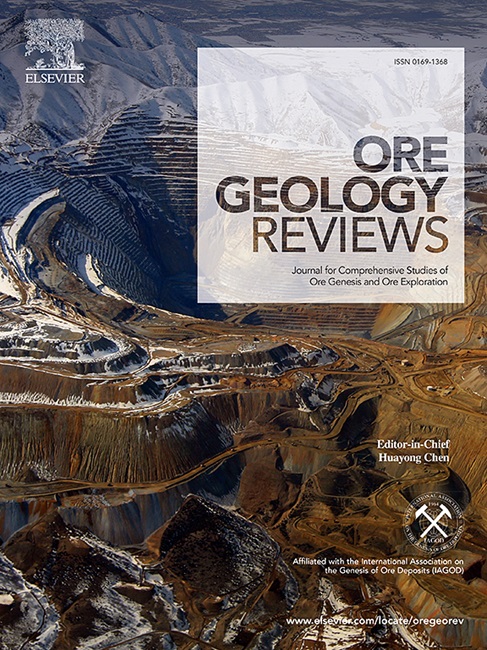Gold mineralization of the Huangjindong gold deposit in the Jiangnan Orogen, South China: Constraints from fluid inclusions and LA-ICP-MS analysis of pyrite and arsenopyrite
IF 3.2
2区 地球科学
Q1 GEOLOGY
引用次数: 0
Abstract
The Huangjindong gold deposit (∼80 t Au @ 5 g/t) is located in the middle segment of the Jiangnan Orogenic Belt, South China. Mineralization of the deposit is mainly controlled by the NE-trending faults and a series of EW-NWW-trending inverted folds, which are dominated by auriferous quartz veins, altered slates and breccias. As the gold-bearing minerals, pyrite and arsenopyrite are both classified into two generations (Py1, Py2, Apy-a and Apy-b). The mineralization comprises three stages, Py1 + quartz + sericite (stage I), Py2 + arsenopyrite + gold + galena + sphalerite + chalcopyrite + tetrahedrite + quartz (stage II), and quartz + chlorite + calcite (stage III). To understand the characteristics of gold mineralization and the ore-forming conditions, we conducted comprehensive studies of the fluid inclusions, EPMA, LA-ICP-MS and thermodynamic analyses. The microthermometric results reveal that the ore-forming fluids may have two temperature peaks at ∼180 °C and ∼280 °C. The EPMA results show that the fineness of the native gold ranges from 978 to 1000 (mean 995.9). The LA-ICP-MS analyses of fluid inclusions, pyrite and arsenopyrite formed at different stages reveal the distinct distributions of trace elements. Since the processed data from the LA-ICP-MS mapping analyses reveals that the Au/Ag values of Py2 (10–1000) and arsenopyrite (10–10,000) are higher than that of Py1 (0.1–100), we conducted thermodynamic calculations and plotted the 3D isopleth models for the gold solubility and the Au/Ag ratio. The results of this study suggest that gold mineralization mainly occurs in stage II with higher Au/Ag ratios and higher temperatures, and the decreased sulfur concentration might have caused large-scale gold precipitation.

江南造山带黄金洞金矿床金矿化:流体包裹体约束及黄铁矿、毒砂的LA-ICP-MS分析
黄金洞金矿床(~ 80 t Au @ 5 g/t)位于华南江南造山带中段。矿床成矿主要受ne向断裂和ew - nww向一系列逆褶皱控制,以含金石英脉、蚀变板岩和角砾岩为主。黄铁矿和毒砂作为含金矿物,均分为Py1、Py2、Apy-a和Apy-b两代。成矿作用分为Py1 +石英+绢云母(第1阶段)、Py2 +毒砂+金+方铅矿+闪锌矿+黄铜矿+四面体+石英(第2阶段)和石英+绿泥石+方解石(第3阶段)3个阶段。为了解金矿化特征和成矿条件,对流体包裹体进行了综合研究,并进行了EPMA、LA-ICP-MS和热力学分析。显微测温结果表明,成矿流体在~ 180°C和~ 280°C有两个温度峰。EPMA结果表明,金矿金的细度范围为978 ~ 1000,平均为995.9。对不同阶段形成的流体包裹体、黄铁矿和毒砂进行LA-ICP-MS分析,发现微量元素的分布有明显差异。由于LA-ICP-MS制图分析的处理数据显示,Py2(10-1000)和毒砂(10 - 10000)的Au/Ag值高于Py1(0.1-100),我们进行了热力学计算,并绘制了金溶解度和Au/Ag比的三维等线模型。研究结果表明,金矿化主要发生在Au/Ag比值较高、温度较高的II期,硫浓度的降低可能导致了大规模的金沉淀。
本文章由计算机程序翻译,如有差异,请以英文原文为准。
求助全文
约1分钟内获得全文
求助全文
来源期刊

Ore Geology Reviews
地学-地质学
CiteScore
6.50
自引率
27.30%
发文量
546
审稿时长
22.9 weeks
期刊介绍:
Ore Geology Reviews aims to familiarize all earth scientists with recent advances in a number of interconnected disciplines related to the study of, and search for, ore deposits. The reviews range from brief to longer contributions, but the journal preferentially publishes manuscripts that fill the niche between the commonly shorter journal articles and the comprehensive book coverages, and thus has a special appeal to many authors and readers.
 求助内容:
求助内容: 应助结果提醒方式:
应助结果提醒方式:


